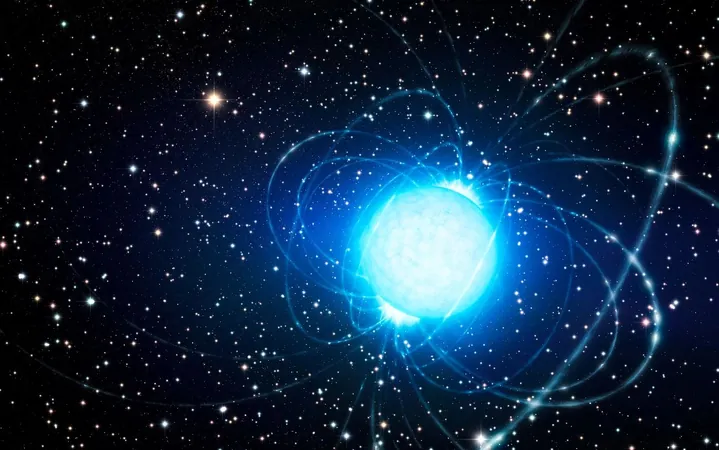
Unraveling the Mystery: Gravitational Waves May Shed Light on Fast Radio Bursts
2025-01-13
Author: Ming
Introduction
Fast Radio Bursts (FRBs) are one of the most intriguing enigmas in modern astrophysics—quick flashes of energy lasting from mere milliseconds to a staggering three seconds. While the majority of these bursts originate from beyond our galaxy, a striking find came in 2020 when scientists detected an FRB emanating from SGR 1935+2154, a magnetar located approximately 20,000 light-years away in our Milky Way.
Theories and Investigations
These enigmatic signals have sparked theories about their origins, with astrophysicists predominantly suspecting that they arise from high-energy astrophysical processes. However, the precise mechanisms behind FRBs remain shrouded in uncertainty. To shed light on this phenomenon, researchers have now turned to gravitational waves (GWs) as a potential key to understanding FRBs.
Recent Study
In a recent study published in The Astrophysical Journal, an international team of scientists employed the UK-German GEO600 gravitational wave detector to investigate the connection between FRBs and gravitational waves specifically focusing on SGR 1935+2154. This incredibly energetic magnetar is known for its powerful magnetic field and has been linked to some of the strongest FRB emissions detected to date.
Significance of Observations
The lead researcher, A. G. Abac from the Max Planck Institute for Gravitational Physics, emphasized the significance of this link. "Observing fast radio bursts and gravitational waves from a magnetar almost simultaneously would provide the evidence we've long sought," he stated. Such simultaneous observations could establish a direct relationship between the magnetar's stellar quakes and FRB emissions.
GEO600's Role
The GEO600 instrument was key during a unique window of time from 2020 to 2022, when SGR 1935+2154 produced three notable FRB episodes. Despite GEO600's extensive listening, the data analysis yielded no evidence of accompanying gravitational waves. Yet, this absence of detection is not a failure; it still aids scientists in honing their models and understanding the potential limits of GW emissions from these cosmic events.
Previous Attempts and Findings
Interestingly, previous efforts involving larger and more sophisticated detectors like LIGO, Virgo, and KAGRA have similarly failed to catch GWs linked to FRBs. However, those attempts established crucial upper limits on the energy that could have been produced alongside these bursts—suggesting that any gravitational waves emitted must have been much weaker than earlier estimates indicated, potentially up to 10,000 times less energetic.
Future Prospects
Current models continue to explore the generation of gravitational waves during FRBs, although further advancements in observational sensitivity are necessary for clearer differentiation among these theories. The journey toward linking these cosmic phenomena is, by all means, just beginning. Fortunately, with upgraded LIGO, Virgo, and KAGRA detectors expected to be online during future FRB emissions, the scientific community remains optimistic.
Anticipation of New Discoveries
As astrophysicists continue to explore these mysterious bursts, the anticipation builds. "Things could get exciting very soon," notes Karsten Danzmann, director at the AEI. With the international network of detectors now in an observing run until June 2025, the imminent return of SGR 1935+2154's activity could offer another golden opportunity to probe whether FRBs are indeed accompanied by gravitational waves—a potential breakthrough that could unlock an ancient mystery in the universe.
Conclusion
In summary, while much remains to be understood about the connection between magnetars, gravitational waves, and fast radio bursts, advancements in observational technology hold the promise of illuminating the dark corners of astrophysical understanding. Could we soon witness the conclusive evidence that bridges these extraordinary cosmic phenomena? Only time will tell!

 Brasil (PT)
Brasil (PT)
 Canada (EN)
Canada (EN)
 Chile (ES)
Chile (ES)
 Česko (CS)
Česko (CS)
 대한민국 (KO)
대한민국 (KO)
 España (ES)
España (ES)
 France (FR)
France (FR)
 Hong Kong (EN)
Hong Kong (EN)
 Italia (IT)
Italia (IT)
 日本 (JA)
日本 (JA)
 Magyarország (HU)
Magyarország (HU)
 Norge (NO)
Norge (NO)
 Polska (PL)
Polska (PL)
 Schweiz (DE)
Schweiz (DE)
 Singapore (EN)
Singapore (EN)
 Sverige (SV)
Sverige (SV)
 Suomi (FI)
Suomi (FI)
 Türkiye (TR)
Türkiye (TR)
 الإمارات العربية المتحدة (AR)
الإمارات العربية المتحدة (AR)